What happened to the marbles that decorated the Colosseum?
Did you know? What happened to the marbles that decorated the Colosseum? The Colosseum is one of the symbolic monuments of Rome in the world: gigantic, majestic, of great impact and with an “important” history. But what we see today is an amphitheater…

…very different from what could be admired until the imperial period, when it was covered with marble, statues and beautiful decorations. Let’s find out what happened to all these ornaments and what are the monuments where you can admire the old marble of the Colosseum.

The grandeur has remained the same, the marbles are very rare in the magnificent Flavian Amphitheater, an imposing structure built in the Flavian era on an area at the eastern edge of the Roman Forum. Its construction was started by Vespasian in 70 AD. and inaugurated by Tito in 80, with further changes made during Domitian’s empire in 90.

It is the largest amphitheater in the world, capable of holding an estimated number of spectators between 50,000 and 87,000.
In imperial times it was covered with statues and decorations of Mark, even inside, parts that, when the structure was abandoned, served many uses, essentially to build the palaces of the popes and numerous churches throughout the city. Fallen into neglect, for a long time the amphitheater was in fact used as a source of building materials and it is estimated that only a third of the original construction remains.

The Romans began to recycle its materials: travertine could be used as it was or cooked to make lime. The sacking continued during the reign of Theodoric. Everything was reused: the thick marble slabs that lined the corridors, the tuff blocks, the lead of the pipes, the metal clamps that held the blocks together, even the bricks.

Later it was the Church that used the Colosseum as a quarry. Pope Gregory the Great had the Roman basilicas and ancient temples transformed into Christian churches and the systematic stripping of the Flavian amphitheater continued. In the 14th century the Orsini and the Colonna families obtained permission to quarry stones and marbles.

The license to remove materials, obviously for a fee, was easily granted by the Popes. However, it was preferred not to damage the north facade, a monumental background to the religious processions on the way to the Lateran. But behind the façade the stones, marbles and iron clamps for fixing the blocks continued to be quarried. In 1439 these were used to repair the tribune of the Basilica of San Giovanni in Laterano.

In 1452 2,522 loads of material were removed by a certain Giovanni Foglia di Como. Ten years later, travertines were used for the construction of the Scala Santa, the city walls, the Basilica of San Marco and Palazzo Venezia. The most valuable blocks were used for the square and the loggia of blessings in San Pietro. In the following century the Colosseum contributed to the construction of the Palazzo della Cancelleria, Palazzo Farnese, the Palazzi Senatorio and Conservatori on the Campidoglio and in 1634 of Palazzo Barberini. Finally, in 1703, the travertine ended up in the port of Ripetta, then demolished for the construction of the Tiber walls.
